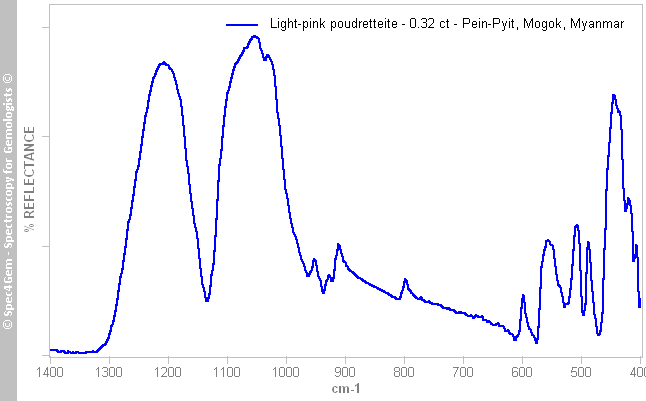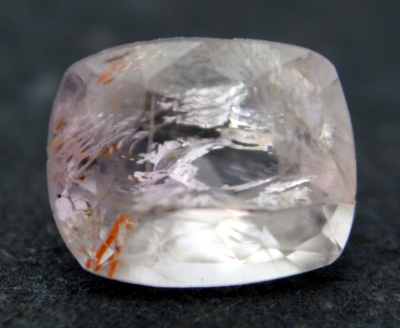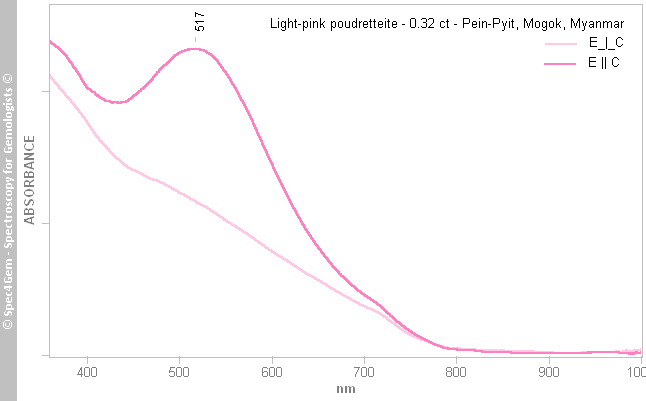Light pink poudretteite from Pein-Pyit, Mogok township, Myanmar
- Details
- Created: Sunday, 27 January 2019 20:12
Poudretteite is an extremely rare mineral and gemstone that was first discovered as minute crystals in Mont St. Hilaire, Quebec, Canada, during the sixties. The mineral was named for the Poudrette family operating the quarry it was found from [1]. Since then, in the 2000s, it has also been discovered in Myanmar, in the Pyant Gyi mine, Pein-Pyit, Mogok Township, Pyin-Oo-Lwin District, Mandalay Division[2]. The few stones were originaly identified as scapolite. Poudretteite is a member of the osumilite group of minerals that also includes milarite, sogdianite and sugilite.
Such a gemstone remains a collector's stone, its hardness is just 5 or slightly above but the main reason is more likely its scarsity at the moment. The gemstone of this work is only 0.32 ct and is included as it can be observed in figure 1. The light pink color is not at its best, better stones show a more vivid pink to puplish-pink color. Nevertheless, this sample stone is a great specimen for studying the material.
| Shape | cushion |
| Size | 4.8 x 3.7 x 3.0 mm |
| Color | light pink |
| Lustre | vitreous |
| Weight | 0.32 ct |
| SG | - |
| RI | 1.510 - 1.530 |
| DR | 0.020 U+ |
| Pleochroism | purple / almost colorless |
| Polariscope / Conoscope | anisotropic: light/dark 4 times / 360°, conoscope not used |
| SWUV | inert |
| LWUV | inert |
| Magnetic susceptibility N52 | diamagnetic |
| Chelsea filter | inert |
Table 1. Observational and measured properties
Infrared reflectance spectroscopy:
The infrared reflectance spectrum (figure 2) was collected from the gemstone's table without any particular orientation. It is consistent with the poudretteite IR spectra obtained with other spectroscopic methods, KBr pellet absorption[2] and transmittance[3].
 Figure 2. The IR reflectance spectrum collected from the gemstone's table is similar to other poudretteite spectra obtained by other IR spectroscopic methods.
Figure 2. The IR reflectance spectrum collected from the gemstone's table is similar to other poudretteite spectra obtained by other IR spectroscopic methods. UV-VIS-NIR spectroscopy:
The dichroscope has shown a strong pleochroism from almost colorless to strong purplish-pink. For that dichroism, it has been found interesting to collect polarized UV-Vis-NIR absorption spectra. Figure 3 depicts the two spectra which all have a common pattern with an absorption continuum starting around 800 nm and increasing towards UV. The E||C spectrum differs from E_|_C one by a relatively strong and large absorption band centered around 517 nm. A weak absorption feature is also present in both spectra around 720 nm.
The polarization dependant absorption band is possibly explained by Mn as suggested by Smith et al. in their article published in 2003[2]. Mn is proposed by analogy with other pink, purple or red stones such as rhodochrosite, tourmaline, bixbite and also sugilite. In the osumilte group as the poudretteite, the sugilite is colored by Mn3+.
Photoluminescence spectroscopy:
Not any of the following sources have induced any photoluminescence: 254, 377, 405 nm. Any manganese (Mn) luminescence would have support the earlier hypothesis that this poudretteite owed its color to Mn3+.
Conclusion:
All data are consistent with poudretteite, there is room left for doubt about it. The UV-Vis spectroscopy lead to suppose the color is possibly caused by Mn3+ but this is not confirmed and photoluminescence was helpless to confirm it since no luminescencence was detected.
[1] Poudretteite, a new member of the osumilite group from Mont Saint-Hilaire, Quebec, J.D. Grice, T. Scott Ercit, J. Van Velthuizen, P. J. Dunn, The Canadian Mineralogist, 1987, Vol. 25, pp. 763-766
[2] Poudretteite - A Rare Gem Species from the Mogok Valley, C. P. Smith, G. Bosshart, S. Graeser, H. Hänni, D. Günther, K. Hametner, E. J. Gübelin, Gems & Gemology, 2003, Spring, pp. 24-31
[3] Infrared spectra of mineral species, Nikita V. Chukanov, 2014, Springer Editor, ISBN: 978-94-007-7128-4



